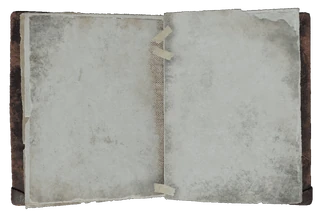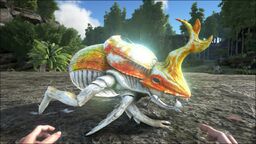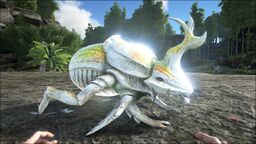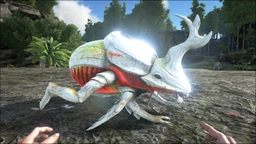(→Taming Strategy: Clarified the value of stats on this creature) Tag: Visual edit |
ElegantExcalibur (talk | contribs) m (Grammar, links, capitalization) Tag: Visual edit |
||
| Line 4: | Line 4: | ||
| sound = |
| sound = |
||
| group = Invertebrates |
| group = Invertebrates |
||
| − | | species = Scarabidae |
+ | | species = Scarabidae gigas |
| time = Holocene |
| time = Holocene |
||
| diet = Coprophagic |
| diet = Coprophagic |
||
| Line 96: | Line 96: | ||
Dung Beetles are found in caves and tamed non-violently, but they become aggressive if you are too close. An aggravated beetle will attack and cannot be tamed until it goes back to being passive. They also can be lifted by an [[Argentavis]] or [[Quetzal]]. |
Dung Beetles are found in caves and tamed non-violently, but they become aggressive if you are too close. An aggravated beetle will attack and cannot be tamed until it goes back to being passive. They also can be lifted by an [[Argentavis]] or [[Quetzal]]. |
||
| − | When choosing a target keep in mind that the level of the Dung Beetle is almost irrelevant as a level 1 Dung Beetle will produce entirely the same results as a level 200 Dung Beetle. The only difference is the weight they can carry, which translates to the amount of Feces you can |
+ | When choosing a target keep in mind that the level of the Dung Beetle is almost irrelevant as a level 1 Dung Beetle will produce entirely the same results as a level 200 Dung Beetle. The only difference is the weight they can carry, which translates to the amount of Feces you can load on it. |
| − | While it is possible to tame anywhere, these beetles appear most frequently near water sources (past the first cluster of snakes in Central cave for example) it is advised to draw them closer to the cave entrance for safety. positioning your |
+ | While it is possible to tame anywhere, these beetles appear most frequently near water sources (past the first cluster of snakes in Central cave for example) it is advised to draw them closer to the cave entrance for safety. positioning your [[Sabertooth]] at a choke point to prevent other players from interfering with your tame is advised on PvE. When not aggravated, the beetle will remain stationary making it easy to tame. Time lost by aggravating the beetle varies up to 3 to 5 minutes, which is added to the feeding interval time. As of Jan 16 2016 the Beetle's pathing is buggy: Luring a tamed Beetle from a cave can be done by lowering its follow distance to the player and by punching the Beetle around awkward obstacles. Keep in mind, this strategy might knock the Beetle unconscious, or even kill the Beetle if the player is too reckless; as such, getting them out of caves can be tedious. There is also a bug which can occur once aggravated where the beetle will no longer reliably accept feeding and will eventually die of hunger. |
Bug repellent appears to have no effect. |
Bug repellent appears to have no effect. |
||
| Line 124: | Line 124: | ||
===Strategy=== |
===Strategy=== |
||
| − | To tame, slowly approach the dung beetle from behind and stand right next to it and start feeding it poop. Once fed, just go into your inventory and keep getting poop. It should not get aggressive. A |
+ | To tame, slowly approach the dung beetle from behind and stand right next to it and start feeding it poop. Once fed, just go into your inventory and keep getting poop. It should not get aggressive. A [[Phiomia]] poop farm is recommended. For easier taming, you can make it aggressive (jumping on it will be enough) then make it follow you until you are out of the cave, then start the taming. The Dung Beetle move very slowly and glitch very often in the caves while tamed. A alternate approach is possible with the Grappling Hook. Attach it to the beetle and drag it out of the cave after taming. |
For killing, any weapon will do, as they are relatively weak and fragile. Ranged weapons are not practical, as even a stone pick can kill one quickly. |
For killing, any weapon will do, as they are relatively weak and fragile. Ranged weapons are not practical, as even a stone pick can kill one quickly. |
||
| Line 132: | Line 132: | ||
===Dangers=== |
===Dangers=== |
||
| − | Beware other animals in the cave. A big fight can usually rile up all of the cave's inhabitants, including the beetle. While the player may be swinging away with a pike at nearby Onyc, a beetle can attack, possibly leading to death on either hand. Beware, as the beetle does a surprising amount of knock back. Stay away from the lava or spike pits in caves that contain them, as to avoid a embarrassing and untimely death via a disgruntled Dung Beetle. |
+ | Beware other animals in the cave. A big fight can usually rile up all of the cave's inhabitants, including the beetle. While the player may be swinging away with a pike at nearby [[Onyc]], a beetle can attack, possibly leading to death on either hand. Beware, as the beetle does a surprising amount of knock back. Stay away from the lava or spike pits in caves that contain them, as to avoid a embarrassing and untimely death via a disgruntled Dung Beetle. |
===Weakness=== |
===Weakness=== |
||
| Line 168: | Line 168: | ||
* This dossier was revealed on 08/05/2015 <ref>[http://steamcommunity.com/games/346110/announcements/detail/111814120384997437 ARK Digest #13, & Introducing the Dung Beetle!]</ref> |
* This dossier was revealed on 08/05/2015 <ref>[http://steamcommunity.com/games/346110/announcements/detail/111814120384997437 ARK Digest #13, & Introducing the Dung Beetle!]</ref> |
||
* The dung beetle's genus ''Scarabidae'' actually refers to the group that dung beetles belong in, the scarab beetles. |
* The dung beetle's genus ''Scarabidae'' actually refers to the group that dung beetles belong in, the scarab beetles. |
||
| − | * At one point in the dung beetle dossier, the author refers them as worthy of being |
+ | * At one point in the dung beetle dossier, the author refers them as worthy of being worshiped. Presumably this is a reference to how the Ancient Egyptians considered them to be sacred. |
* You must be within range of the dung beetle for it to process feces into fertilizer and oil.{{cn}} <!-- What exactly is "in range"? And when was this change made - sometime between January and April 2016?--> |
* You must be within range of the dung beetle for it to process feces into fertilizer and oil.{{cn}} <!-- What exactly is "in range"? And when was this change made - sometime between January and April 2016?--> |
||
Revision as of 02:32, 9 May 2016
or
cheat SpawnDino "Blueprint'/Game/PrimalEarth/Dinos/DungBeetle/DungBeetle_Character_BP.DungBeetle_Character_BP'" 500 0 0 35
The Dung Beetle is one of the Creatures in ARK: Survival Evolved.
Basic Info
Dossier
- Wild: What magic created the Scarabidae gigas, I cannot say. What I can say is that this creature is a perfect symbiont for advanced human tribes.
- Domesticated: Scarabidae makes me think humans have been on the island for a long time. Why else would a creature evolve to be such a perfect pet? Most tribes jealously protect their Scarabidae, whom are handily tamed with the skilled use of some well-handled feces. These wondrous little organic biofactories are truly a sustainable, green, eco-friendly source of resources for living off the land. Oil becomes gas, which is generator fuel. Fertilizer means crops, which is human fuel. The scarabidae can power all aspects of island life!
- Known Information: Coprophagic, it eats mostly useless waste (feces). It metabolizes this waste into a more refined waste product, along with an oily byproduct. The oily byproduct is chemically the same as the oil found in the oceans around the island. Somehow, Scarabidae converts feces into oil. If that wasn't reason enough to worship the Scarabidae, the refined waste product is almost identical to fertilizer from a compost bin.
Behavior
Appearance
The Dung Beetles of the ARK are far larger than any species known to science, but are as equally tireless in their duties. They are most often found in the island's caves, feeding on the massive quantities of bat guano and, in turn, being eaten by the giant spiders and scorpions. They have colorful shells, but these do not hide wings as Scarabidae gigas are incapable of flight. Both sexes also bear horns which they use to spar each other for the choicest piles of droppings. Their digestive systems are the most marvelous on the island, converting waste matter into an oil-like substance and a type of fertilizer.
This section displays the Dung Beetle's natural colors and regions. For demonstration, the regions below are colored red over an albino Dung Beetle. The colored squares shown underneath each region's description are the colors that the Dung Beetle will randomly spawn with to provide an overall range of its natural color scheme. Hover your cursor over a color to display its name and ID.
This information can be used to alter the Dung Beetle's regions by entering cheat SetTargetDinoColor <ColorRegion> <ColorID> in the cheat console. For instance, cheat SetTargetDinoColor 0 6 would color the Dung Beetle's "shell" magenta.
Drops
Base Stats and Growth
| Attribute | Base Value | Level Increase | Taming Bonus | ||
|---|---|---|---|---|---|
| Wild | Tamed | Additive | Multiplicative | ||
| 200 | +4000 | +60.2% | 0.0105 | ||
| 100 | +1000 | +1000% | |||
| 150 | +1500 | +1000% | |||
| 900 | +9000 | +1000% | |||
| 5 | +10 | +800% | |||
| 5 | +20 | +34% | Expression error: Unrecognized punctuation character "%". | Expression error: Unrecognized punctuation character "%".% | |
| 100% | N/A | +250% | |||
| 200 | +12 | N/A | 0.5 | ||
- For a comparison of the stats of all creatures, see Base Creature Statistics.
- For an explanation of exactly how the levelup calculation works, see Creature Stats Calculation.
| Movement [u/s] |
Base Speed | Sprinting Speed | Stamina | ||||
|---|---|---|---|---|---|---|---|
| Wild | Tamed1 | Tamed2 | Wild | Tamed1 | Tamed2 | ||
| Walking | 52 | ? | ? | 260 | 260 | 260 | ? |
| Swimming | 200 | ? | ? | ? | ? | ? | ? |
- 1These are the base speeds of the creature at 100% Movement Speed.
- 2These are the speeds of the creature tamed and non-imprinted.
- For a comparison of the speeds of all creatures, see Base Creature Speeds.
| Melee | Stamina Cost | Attack Range | Description | ||||||||||
|---|---|---|---|---|---|---|---|---|---|---|---|---|---|
| Base | Minimum | Activation | The Dung Beetle attacks the target. | ||||||||||
| 0 | 170 | 0 | 250 | ||||||||||
| Attack Type | Damage | Projectile Values | Torpor Values | Status Effect: Stamina | Status Effect: Torpidity | ||||||||
| Life | Impulse | Radius | Base | Mult | Duration | Damage Mult | Amount | Duration | Damage Mult | Amount | |||
| Melee | 5 | ||||||||||||
Taming
| Feeding Interval | Time | ||
|---|---|---|---|
| 2 | 05:00 | 0:05:00 | |
| 2 | 03:20 | 0:03:20 | |
| 3 | 05:00 | 0:10:00 | |
| 4 | 01:06 | 0:03:20 | |
| 4 | 00:53 | 0:02:40 | |
| 16 | 01:04 | 0:16:00 | |
| 40 | 00:30 | 0:20:00 | |
| Feeding Interval | Time | ||
|---|---|---|---|
| 3 | 03:45 | 0:07:30 | |
| 4 | 02:13 | 0:06:40 | |
| 6 | 04:00 | 0:20:00 | |
| 8 | 00:57 | 0:06:40 | |
| 10 | 00:44 | 0:06:40 | |
| 40 | 01:01 | 0:40:00 | |
| 100 | 00:30 | 0:50:00 | |
| Feeding Interval | Time | ||
|---|---|---|---|
| 5 | 03:07 | 0:12:30 | |
| 7 | 01:56 | 0:11:40 | |
| 10 | 03:42 | 0:33:20 | |
| 13 | 00:54 | 0:10:50 | |
| 17 | 00:42 | 0:11:20 | |
| 65 | 01:00 | 1:05:00 | |
| 163 | 00:30 | 1:21:30 | |
| Feeding Interval | Time | ||
|---|---|---|---|
| 6 | 03:00 | 0:15:00 | |
| 9 | 01:52 | 0:15:00 | |
| 14 | 03:35 | 0:46:40 | |
| 18 | 00:52 | 0:15:00 | |
| 23 | 00:41 | 0:15:20 | |
| 90 | 01:00 | 1:30:00 | |
| 225 | 00:30 | 1:52:30 | |
| Feeding Interval | Time | ||
|---|---|---|---|
| 8 | 02:51 | 0:20:00 | |
| 12 | 01:49 | 0:20:00 | |
| 18 | 03:31 | 1:00:00 | |
| 23 | 00:52 | 0:19:10 | |
| 29 | 00:41 | 0:19:20 | |
| 115 | 01:00 | 1:55:00 | |
| 288 | 00:30 | 2:24:00 | |
| Feeding Interval | Time | ||
|---|---|---|---|
| 10 | 02:46 | 0:25:00 | |
| 14 | 01:47 | 0:23:20 | |
| 21 | 03:30 | 1:10:00 | |
| 28 | 00:51 | 0:23:20 | |
| 35 | 00:41 | 0:23:20 | |
| 140 | 01:00 | 2:20:00 | |
| 350 | 00:30 | 2:55:00 | |
Note that the values are for optimal cases, always bring extra supplies!
For a level-dependent count of resources needed, try an external taming calculator.
Taming Strategy
Dung Beetles are found in caves and tamed non-violently, but they become aggressive if you are too close. An aggravated beetle will attack and cannot be tamed until it goes back to being passive. They also can be lifted by an Argentavis or Quetzal.
When choosing a target keep in mind that the level of the Dung Beetle is almost irrelevant as a level 1 Dung Beetle will produce entirely the same results as a level 200 Dung Beetle. The only difference is the weight they can carry, which translates to the amount of Feces you can load on it.
While it is possible to tame anywhere, these beetles appear most frequently near water sources (past the first cluster of snakes in Central cave for example) it is advised to draw them closer to the cave entrance for safety. positioning your Sabertooth at a choke point to prevent other players from interfering with your tame is advised on PvE. When not aggravated, the beetle will remain stationary making it easy to tame. Time lost by aggravating the beetle varies up to 3 to 5 minutes, which is added to the feeding interval time. As of Jan 16 2016 the Beetle's pathing is buggy: Luring a tamed Beetle from a cave can be done by lowering its follow distance to the player and by punching the Beetle around awkward obstacles. Keep in mind, this strategy might knock the Beetle unconscious, or even kill the Beetle if the player is too reckless; as such, getting them out of caves can be tedious. There is also a bug which can occur once aggravated where the beetle will no longer reliably accept feeding and will eventually die of hunger.
Bug repellent appears to have no effect.
Because of how difficult it is to get a Dung Beetle out of a cave once tamed, it is recommended to lure it outside while it is attacking you and tame it at the cave entrance. Running backwards in circles until the beetle tires out will allow you to feed it. Once fed, the beetle will attack again. Just rinse and repeat running backwards in circles until the creature is tamed.
Alternatively, you can lure it outside of the cave and pick it up with an Argentavis or Quetzal and relocate it to a taming pen near or at your base for easy taming. That way, you'll know where it is and it will be protected from (most) other creatures during the taming process.
You can safely drag one out of the water area in the North East cave with the use of a grappling hook.
Preferred Food
- They will eat Meat and Kibbles, but the taming rate is lower than Human Feces so it is not recommended.
- Spoiled meat works but is very inefficient
- When on wander, they will eat a person's body.
- After taming, keeping feces in the beetle will not be enough to keep its food up. Provide the beetle with meat via a trough or directly in its inventory to keep it fed.
Combat
This section describes how to fight against the Dung Beetle.
General
The Dung Beetle is not a dangerous animal, but one should always consider that it is not defenseless!
Strategy
To tame, slowly approach the dung beetle from behind and stand right next to it and start feeding it poop. Once fed, just go into your inventory and keep getting poop. It should not get aggressive. A Phiomia poop farm is recommended. For easier taming, you can make it aggressive (jumping on it will be enough) then make it follow you until you are out of the cave, then start the taming. The Dung Beetle move very slowly and glitch very often in the caves while tamed. A alternate approach is possible with the Grappling Hook. Attach it to the beetle and drag it out of the cave after taming.
For killing, any weapon will do, as they are relatively weak and fragile. Ranged weapons are not practical, as even a stone pick can kill one quickly.
Weaponry
Any weapon will do, but ranged weapons are not practical.
Dangers
Beware other animals in the cave. A big fight can usually rile up all of the cave's inhabitants, including the beetle. While the player may be swinging away with a pike at nearby Onyc, a beetle can attack, possibly leading to death on either hand. Beware, as the beetle does a surprising amount of knock back. Stay away from the lava or spike pits in caves that contain them, as to avoid a embarrassing and untimely death via a disgruntled Dung Beetle.
Weakness
The dung beetle is not a practical fighter because of its speed, attack damage, and health; this creature is not really meant for battling, it is prized more for its fertilizer and good looks. On PVP servers, make sure to keep them well protected, as they can be killed in a raid quickly.
Utility
Roles
The Dung Beetle can convert feces placed in its inventory into Fertilizer and Oil. 'Wandering' must be enabled for conversion to occur so be sure to place the beetle within a pen where it can wander freely without fear of it escaping. It will not collect feces; these have to be placed manually in the bug. Due to the low starting Weight, it is recommended to level up this stat in order to place more feces in its inventory, and due to low health, it is advisable to house these in an enclosed or otherwise protected area. 2 high wooden railings is sufficient to prevent escape.
| Weight | Converts to | ||
|---|---|---|---|
| 0.1 | 1 | 2 | |
| 0.3 | 1 | 2 | |
| 1.5 | 2 | 4 | |
| 4.0 | 3 | 6 |
Conversion of feces into fertilizer takes 15 minutes per conversion. However, it can convert one batch of each type of feces concurrently. For example, if you place 1 Human Feces, 2 Small Animal Feces, 1 Medium and 1 Large, you will have 7 fertilizer and 14 oil after 15 minutes (not 60 minutes). Production of same size feces is otherwise queued. For example, if you place 4 Small Feces, 1 Medium, and 1 Large, you will have 6 Fertilizer and 12 oil after 15 minutes, and an additional 1 Fertilizer and 2 oil after a further 15 minutes (30 minutes total).
Level weight exclusively, no other stat has any effect on the Fertilizer production.
Spotlight
Notes/Trivia
- This dossier was revealed on 08/05/2015 [1]
- The dung beetle's genus Scarabidae actually refers to the group that dung beetles belong in, the scarab beetles.
- At one point in the dung beetle dossier, the author refers them as worthy of being worshiped. Presumably this is a reference to how the Ancient Egyptians considered them to be sacred.
- You must be within range of the dung beetle for it to process feces into fertilizer and oil.[citation needed]










































































































































































































































































